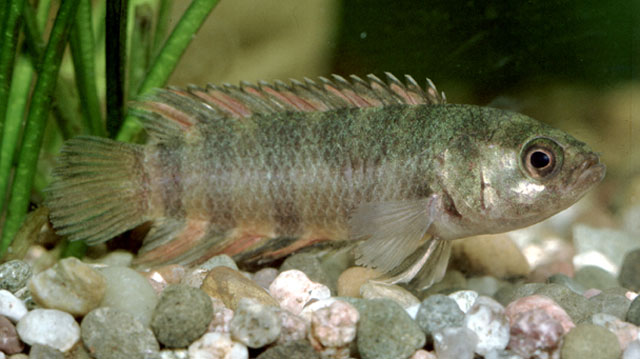| Anabantidae (Climbing gouramies) |
| 5.4 cm SL (male/unsexed) |
|
benthopelagic; freshwater; pH range: 6 - 8; dH range: 5 - 19, |
| Africa: Chiloango River, and widespread in the central Congo basin; possibly also in the Nyong in Cameroon (Ref. 81650). Report from tropical West Africa (Ref. 4537) unconfirmed (Ref. 57414). |
|
Dorsal spines (total): 16-19; Dorsal soft rays (total): 6-10; Anal spines: 10-12; Anal soft rays: 7-10; Vertebrae: 26-27. Diagnosis: dorsal fin with 16-19 spines and 6-8 soft rays; anal fin with 10-12 spines and 7-10 soft rays; subopercle rarely serrated (in adults); caudal fin rounded in adults; caudal peduncle very short; flanks barred, breeding males marked with orange on flanks (Ref. 81650).
Description: one of the smaller species in the genus, adults rarely larger than 45 mm SL; snout blunt; head profile rounded; body fusiform with very short caudal peduncle and rounded fin; 1-9 scales in upper lateral line, 2-7 in lower; 2-3 scales above upper lateral line, 6-7.5 scales below; 1-5 serrations above opercular notch, none within notch, 1 below, no subopercular serrations (rarely 1-3), interopercle and preopercle entire (Ref. 81650).
Coloration: 7-8 dark vertical bars on flanks, each narrower than pale interspaces; bars more pronounced in males than females, and continue onto dorsal and anal fins in males, but not in female or juveniles; interspaces in living specimens usually orange with colour more intense and extensive in males, especially so when breeding; 2 dark streaks radiate from posterior border of orbit; pelvic fins with a single median black stripe; leading edge of pelvics and tips of dorsal and anal rays and spines white; ocellated caudal spot in juveniles up to 25 mm SL, sometimes faintly visible up to 37 mm SL (Ref. 81650). |
| Maximum total length reported 8.0 cm (Ref. 6803). |
|
Least Concern (LC); Date assessed: 16 February 2009 Ref. (130435)
|
| harmless |
Source and more info: www.fishbase.org. For personal, classroom, and other internal use only. Not for publication.

